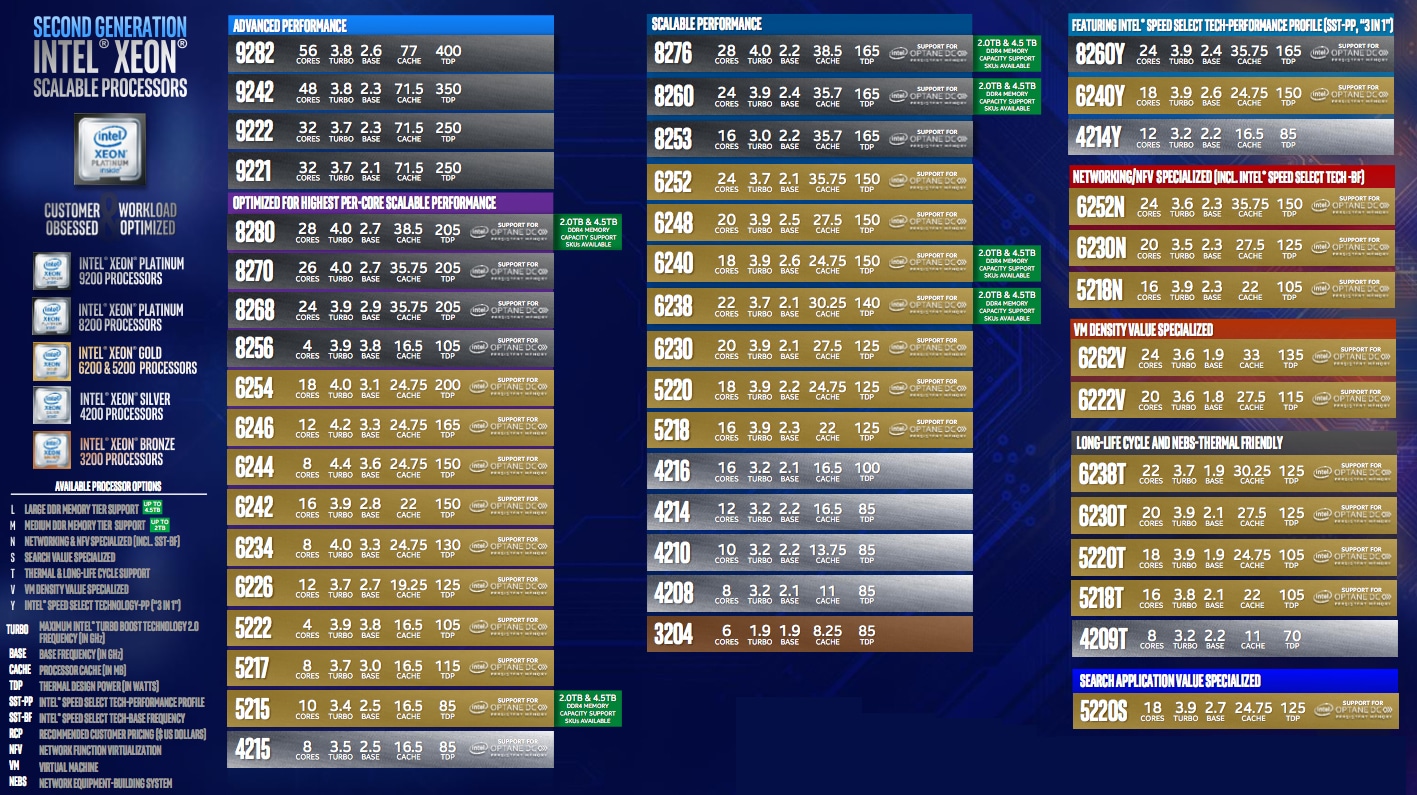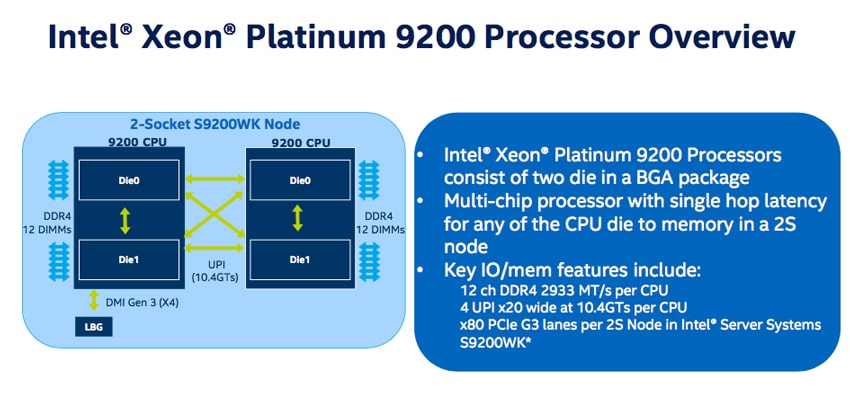
As part of its biannual update, Intel today announced updates to its Xeon Scalable processors from platinum to bronze, in the form of second generation Intel Xeon Scalable. These new CPU’s come with the promise of higher processing power, no real surprise there, with some offer core counts as high as 56. A big aspect of this release is the fact that several of the new CPUs, which are socket compatible, will allow servers to leverage Intel’s Optane DC Persistent Memory, which we go into some detail here.
One thing that is needed across the board is usually higher performance and more capacity. Intel’s release of second generation Intel Xeon Scalable processors definitely comes with the promise of higher performance. With the massive growth of data (90% of which was created in the last 2 years) and new technologies such as AI and ML, organizations are looking for ways to better leverage their data and gain insights quicker. Intel is raising to the challenge with its most expansive portfolio of Xeon processors to date. Key features of the new CPUs include:
- Integration of Intel Deep Learning Boost (Intel DL Boost) technology optimized to accelerate AI inference workloads like image-recognition, object-detection and image- segmentation within data center, enterprise and intelligent-edge computing environments. Intel has worked extensively with ecosystem partners to optimize frameworks (TensorFlow, PyTorch, Caffe, MXNet and Paddle Paddle) and applications that take full advantage of Intel DL Boost technology. Customers can choose enhanced tools like OpenVINO to ease deployment.
- Support for the Intel Optane DC persistent memory, which brings affordable high-capacity and persistence to Intel’s data centric compute portfolio. By moving more data into memory, this innovation allows users to unleash faster insights from their data and delivers up-to 36TB of system-level memory capacity when combined with traditional DRAM in an eight-socket system. This represents a 3X increase in system memory capacity compared to the previous generation Intel Xeon Scalable processor.
- The addition of several hardware-enhanced security features that help build a more trusted foundation for computing, including side channel protections built directly into hardware.
While the entire line was refreshed, Intel announced a new platinum 9200 line of CPUs for advanced performance. The highest model, 9282, has 56 cores, 3.8GHz turbo, 77MB of cache, and allows for the highest RAM density, up to 3TB. The other two in the 9200 line aren’t shabby either with 48 cores and 32 cores. Intel released network-optimized Xeon Scalable CPUs that target networking applications to reduce bottlenecks and enable high- performance, efficient, scalable and agile 5G-ready networks. Part of the specific processors is the new Intel Xeon D-1600. This SoC is aimed at the edge, security and storage solutions where there isn’t a lot of power or space, but performance is a must. The D-1600 is also aimed at the path to 5G. The Xeon D-1600 line comes in several models ranging from 2-8 cores up to 3.2 GHz, and up to 128GB of DDR4 2400MT/s RAM support.
Intel has actually released several CPUs what are specific to certain workloads. The table below breaks down the new CPUs, their use cases, and whether or not they support the new Optane DC persistent memory:
| Intel Second Generation Xeon Scalable Processors | ||||||
|---|---|---|---|---|---|---|
| CPU | Cores | Turbo (GHz) | Base | Cache (MB) | TDP | Supports Optane DC persistent memory |
| Advanced performance | ||||||
| Platinum | ||||||
| 9282 | 56 | 3.8 | 2.6 | 77 | 400 | No |
| 9242 | 48 | 3.8 | 2.3 | 71.5 | 350 | No |
| 9222 | 48 | 3.7 | 2.3 | 71.5 | 250 | No |
| 9221 | 32 | 3.7 | 2.1 | 71.7 | 250 | No |
| Optimized for highest per-core scalable performance | ||||||
| Platinum | ||||||
| 8280 | 28 | 4.0 | 2.7 | 38.5 | 205 | Yes |
| 8270 | 26 | 4.0 | 2.7 | 35.75 | 205 | Yes |
| 8268 | 24 | 3.9 | 2.9 | 35.75 | 205 | Yes |
| 8256 | 24 | 3.9 | 3.8 | 16.5 | 105 | Yes |
| Gold | ||||||
| 6254 | 18 | 4.0 | 3.1 | 24.75 | 200 | Yes |
| 6244 | 8 | 4.4 | 3.6 | 24.75 | 150 | Yes |
| 6242 | 16 | 3.9 | 2.8 | 22 | 150 | Yes |
| 6234 | 8 | 4.0 | 3.3 | 24.75 | 130 | Yes |
| 6226 | 12 | 3.7 | 2.8 | 19.25 | 125 | Yes |
| 5222 | 4 | 3.9 | 3.8 | 16.5 | 105 | Yes |
| 5217 | 8 | 3.7 | 3.0 | 16.5 | 115 | Yes |
| 5215 | 10 | 3.4 | 2.5 | 16.5 | 85 | Yes |
| Silver | ||||||
| 4215 | 8 | 3.5 | 2.5 | 16.5 | 85 | Yes |
| Scalable performance | ||||||
| Platinum | ||||||
| 8276 | 28 | 4.0 | 2.2 | 38.5 | 165 | Yes |
| 8260 | 24 | 3.9 | 2.4 | 35.7 | 165 | Yes |
| 8253 | 16 | 3.0 | 2.2 | 35.7 | 165 | Yes |
| Gold | ||||||
| 6252 | 24 | 3.7 | 2.1 | 35.75 | 150 | Yes |
| 6248 | 20 | 3.9 | 2.5 | 27.5 | 150 | Yes |
| 6240 | 18 | 3.9 | 2.6 | 24.75 | 150 | Yes |
| 6238 | 22 | 3.7 | 2.1 | 30.25 | 140 | Yes |
| 6230 | 20 | 3.9 | 2.1 | 27.5 | 125 | Yes |
| 5220 | 18 | 3.9 | 2.2 | 24.75 | 125 | Yes |
| 5218 | 16 | 3.9 | 2.3 | 22 | 125 | Yes |
| Silver | ||||||
| 4216 | 16 | 3.2 | 2.1 | 16.5 | 100 | No |
| 4214 | 12 | 3.2 | 2.2 | 16.5 | 85 | No |
| 4210 | 10 | 3.2 | 2.2 | 13.75 | 85 | No |
| 4208 | 8 | 3.2 | 2.1 | 11 | 85 | No |
| Bronze | ||||||
| 3204 | 6 | 1.9 | 1.9 | 8.25 | 85 | Yes |
| Featuring Intel Speed Select Technology | ||||||
| Platinum | ||||||
| 8260Y | 24 | 3.9 | 2.4 | 35.75 | 165 | Yes |
| Gold | ||||||
| 6240Y | 18 | 3.9 | 2.6 | 24.75 | 150 | Yes |
| Silver | ||||||
| 4214Y | 12 | 3.2 | 2.2 | 16.5 | 85 | No |
| Networking/NFV Specialized | ||||||
| Gold | ||||||
| 6252N | 24 | 3.6 | 2.3 | 35.75 | 150 | Yes |
| 6230N | 20 | 3.5 | 2.3 | 27.5 | 125 | Yes |
| 5218N | 16 | 3.9 | 2.3 | 22 | 105 | Yes |
| VM Density Value Specialized | ||||||
| Gold | ||||||
| 6262V | 24 | 3.6 | 1.9 | 33 | 135 | Yes |
| 6222V | 20 | 3.6 | 1.8 | 27.5 | 115 | Yes |
| Long-life Cycle & NEBS-Thermal Friendly | ||||||
| Gold | ||||||
| 6238T | 22 | 3.7 | 1.9 | 30.25 | 125 | Yes |
| 6230T | 20 | 3.9 | 2.1 | 27.5 | 125 | Yes |
| 5220T | 18 | 3.9 | 2.2 | 24.75 | 105 | Yes |
| Silver | ||||||
| 4209T | 8 | 3.2 | 2.2 | 11 | 70 | No |
| Search Application Value Specialized | ||||||
| Gold | ||||||
| 5220S | 18 | 3.9 | 2.7 | 24.75 | 125 | Yes |
As stated, scalability is also a concern as we move into new realms of Information Technology. Intel released its Optane DC persistent memory modules as well as two other SSDs. The first one, Intel Optane SSD DC D4800X (Dual Port), leverages the company’s Optane storage. Being dual ported, the SSD allows from better data resilience in the face of failures or service operations. Intel is also releasing its Intel SSD D5-P4326 that leverages 64-layer QLC technology. The new drive will offer capacities large enough and affordable enough to displace HDDs in warm storage
Availability
The second generation Intel Xeon Scalable processors are generally available today, and systems using the Intel Xeon Platinum 9200 series expected in the first half of 2019. The Intel Xeon D-1600 CPU and Intel SSD D5-P4326 SSD are also available now. The Intel Optane DC SSD D4800X
Sign up for the StorageReview newsletter


